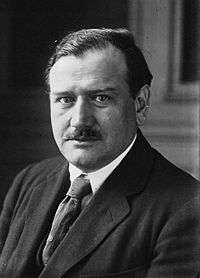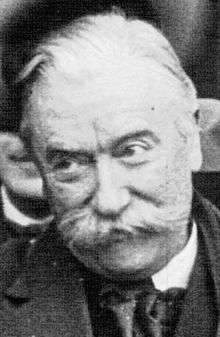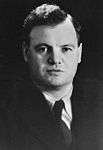French legislative election, 1936
French legislative election, 1936

|
|
|
|
All 610 seats to the Chamber of Deputies
306 seats were needed for a majority |
| |
Majority party |
Minority party |
Third party |
| |
 |
 |
 |
| Leader |
Léon Blum |
Édouard Daladier |
Louis Marin |
| Party |
SFIO |
PRRRS |
FR and RIAS |
| Leader's seat |
Narbonne |
Rhône |
Meurthe-et-Moselle |
| Last election |
132 seats |
160 seats |
59 seats |
| Seats won |
149 |
110 |
100 |
| Seat change |
 17 17 |
 50 50 |
 41 41 |
| Popular vote |
1,955,306 |
1,422,611 |
1,475,793 |
| Percentage |
19.86% |
14.45% |
15.2% |
| Swing |
 0.65% 0.65% |
 4.73% 4.73% |
 2.89% 2.89% |
|
| |
Fourth party |
Fifth party |
| |
 |
 |
| Leader |
Pierre-Étienne Flandin (AD) |
Maurice Thorez |
| Party |
AD-RI |
PCF |
| Leader's seat |
Yonne |
Seine |
| Last election |
121 seats |
10 seats |
| Seats won |
82 |
72 |
| Seat change |
 39 39 |
 62 62 |
| Popular vote |
2,089,166 |
1,502,404 |
| Percentage |
21.33% |
15.26% |
| Swing |
 1.89% 1.89% |
 6.94% 6.94% |
|
|
|
French legislative elections to elect the 16th legislature of the French Third Republic were held on 26 April and 3 May 1936. This was the last legislature of the Third Republic and the last election before World War II. The number of candidates set a record, with 4,807 people vying for 618 seats in the Chamber of Deputies. In the Seine Department alone, there were 1,402 candidates.[1]
The Popular Front, composed of the French Section of the Workers' International (SFIO), the Radical-Socialists, the French Section of the Communist International (SFIC), and miscellaneous leftists, won power from the Léon Blum became President of the Council.
Broad Republican coalitions had governed since the 6 February 1934 crisis:
Government Gaston Doumergue II (Union Nationale, 272 days), Government Flandin I (204 days), Government Bouisson (3 days) and Government Laval IV (229 days).
For the first time, the Radical-Socialists were eclipsed on the left by the SFIO, while still keeping a considerable role in French politics.
Regional results
- The SFIC, predecessor of the Communist Party, doubled its score from 11 SFIC and 9 Union Ouvrière deputies in 1932 to 72 in 1936. The party made gains in industrialized suburbs and working-class areas of major cities. They also progressed in rural central and southwestern France (e.g., Dordogne, Lot-et-Garonne)
- The Radicals lost votes to the SFIO and SFIC, but also to the right.
- The SFIO declined slightly. In working-class suburbs, the party declined, but it gained votes in Brittany, to the dismay of the right.
- Only 174 seats were elected in the first round, 424 were decided in a run-off. The right fared better in the second round.
Results
Popular Vote[2]
Summary of the popular vote in the 26 April and 3 May 1936 Chamber of Deputies election results
| Alliance |
Votes |
% |
Party |
Abbr. |
Votes |
% |
| |
Popular Front |
5,628,321 |
57.17 |
|
French Section of the Workers' International (Section française de l'Internationale ouvrière) |
SFIO |
1,955,306 |
19.86 |
|
French Communist Party (Parti communiste français) |
PCF |
1,502,404 |
15.26 |
|
Republican, Radical and Radical-Socialist Party (Parti républicain, radical et radical-socialiste) |
PRRRS |
1,422,611 |
14.45 |
|
Miscellaneous Left (Divers gauche) |
DVG |
748,600 |
7.60 |
| |
Right and Centre |
4,202,298 |
42.68 |
|
Democratic Alliance (Alliance démocratique), Independent Radicals (Radicaux indépendents), Popular Democrats (Démocrates populaires) |
AD-RI-PDP |
2,536,294 |
25.76 |
|
Republican Federation (Fédération républicaine), Independents, Conservatives |
FR |
1,666,004 |
16.92 |
|
Other parties |
Div |
16,047 |
0.16 |
| Total |
9,846,666 |
100 |
| Abstention: 17.75% |
| Popular vote |
|---|
|
|
|
|
|
| AD-RI-PDP |
|
25.76% |
| SFIO |
|
19.86% |
| FR |
|
16.92% |
| PCF |
|
15.26% |
| PRRRS |
|
14.45% |
| DVG |
|
7.60% |
| Others |
|
0.16% |
Parliamentary Groups[3]

% vote for the Front Populaire in 1936
References






